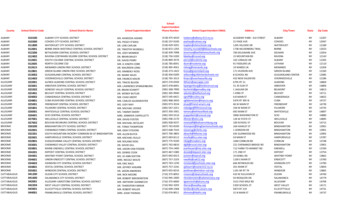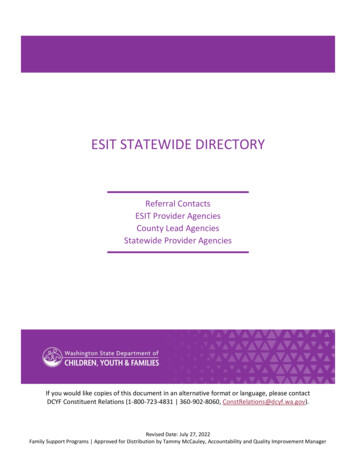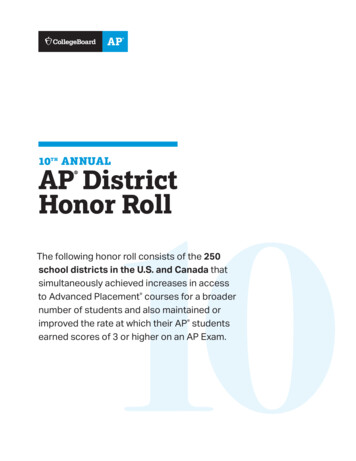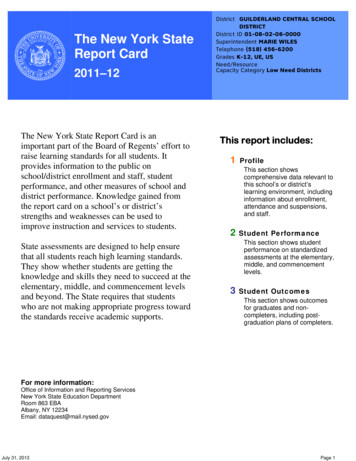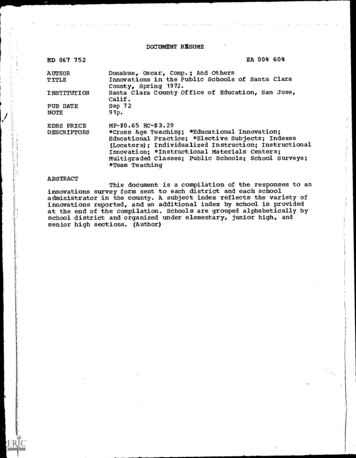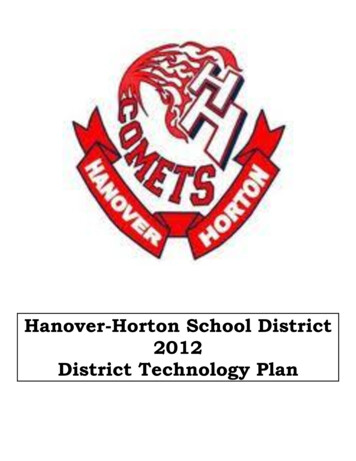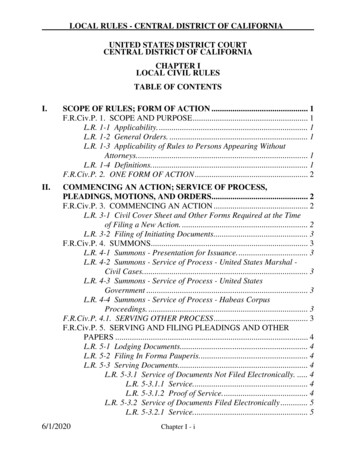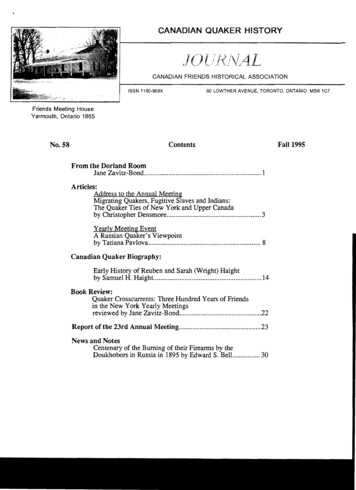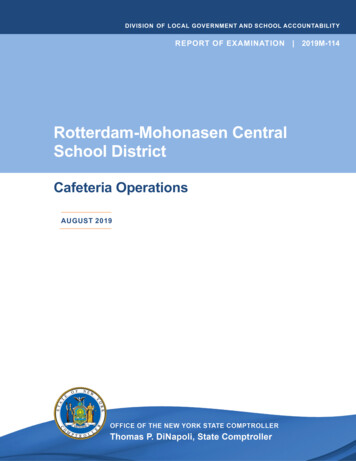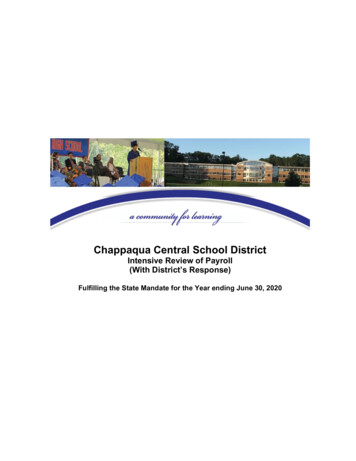
Transcription
Chappaqua Central School DistrictIntensive Review of Payroll(With District’s Response)Fulfilling the State Mandate for the Year ending June 30, 2020
Chappaqua Central School DistrictTable of ContentsCover Letter .1Overview .2Observations and Recommendations . 3-10
To the Board of DirectorsChappaqua Central School DistrictChappaqua, New YorkWe have performed a review in the area of Payroll for the Chappaqua Central SchoolDistrict (the District). as agreed to by the Chappaqua Central School District (the District)for the year ended June 30, 2020. The purpose of this engagement is to ensurecompliance with applicable New York State laws, regulations under the FiscalAccountability Initiative and District’s contractual agreement.Our report provides results of attribute testing performed on the selected area.We are pleased to have had the opportunity to serve you and look forward to reviewing thisreport in detail with you. We would also like to thank the Board of Education and theemployees of the Chappaqua Central School District for their time and assistance duringour engagement.Sincerely,Tobin & CompanyCertified Public Accountants, PCMarch 24, 20202500 WESTCHESTER AVENUE, SUITE 117 PURCHASE, NEW YORK 10577 TEL: (914) 833-2200 FAX: (914) 833-22781
Chappaqua Central School DistrictOverviewRisk AssessmentAt the request of the Board of Education of the Chappaqua Central School District "the District"we performed an Intensive Review of Payroll.During our engagement we performed the following procedures:1) Interview staff responsible for generating, approving and recording of payroll.2) Conducted attribute testing of payroll processes and documentation including:a) Time sheet paper and electronic approval process.b) Payroll comparison report approval process.c) Transaction register certification.d) Confirmation of tax deposits.3) Review of time sheets for proper approval to determine if the approved number ofhours matched to the respective payroll register.4) Reviewed the accuracy of attendance records by comparing the attendance sheetsto the respective Aesop (automated attendance system) reports, and nVision(District accounting software).5) Performed a test of payroll cutoff dates for a sample of former employees todetermine proper:a) Termination effective date.b) Board approval.c) Last payroll date.d) Calculation of final payout computation present.6) Reviewed security procedures over payroll relating to employee bank accountinformation, employee change requests, and payroll wires.7) Review of annual salary rollover computation for accuracy.Key positions interviewed during our process were as follows:Assistant Superintendent for BusinessDistrict TreasurerSenior Office AssistantPayroll BookkeeperPayroll ClerkHuman Resource AssistantAccountant2
Chappaqua Central School DistrictObservations and RecommendationsPayroll Process OverviewBi-weekly pay period.Payroll Bookkeeper.Building Clerks manageattendance in Aesop.Payroll ClerkSalaried employees.(Teachers, Administrators)Salary payroll isgenerated.Hourly employees.(Clerical, Custodians, Substitutes)Custodial and Maintenanceemployees use Time Piecefingerprint system.Clerical, Substitutes,and Teacher aids usemanual timesheets.Principals / Supervisors approvehours.Payroll Clerk reviews hours, thenimports into nVision.Hourly payroll is generated.Earning and deductionreport is printed.The District processes payroll on a bi-weekly pay schedule and the Payroll Department has twoemployees: a Payroll Bookkeeper and a Payroll Clerk. The Payroll Bookkeeper concentrates oncontractual employees such as Teachers and Administrators, and the Payroll Clerkconcentrates on hourly employees such as Clerical, Custodial, and Substitute Teachers.All bargaining units, with the exception of Teachers and Buildings and Grounds employees, arerequired to fill out daily timesheets to track attendance and time worked. The Payroll Clerkenters hours from time sheets and uploads Aesop time into nVision to generate payroll.Teacher’s hours are contractual, so no time sheets are needed. Earnings and Deductionsreports are printed.3
Chappaqua Central School DistrictObservations and RecommendationsPayroll Process Overview (continued)Earning and deduction totals arecompared by Payroll Clerk.Payroll change report is generated andreviewed by the Accountant and Ast. Supfor Business.Payroll certification report is generated and isreviewed and signed by the Asst. Superintendentfor Business.Paycheck stubs are emailed to employees. Livechecks are delivered to each building by courier.Direct deposit payments are processed.The Payroll Bookkeeper prepares payroll taxwithdrawals (done electronically).Treasurer releases payment to the taxing authorities.Deduction totals are prepared and sent to accountspayable for payment.END.Transaction reports as well as payroll change reports are printed for salaried and hourlyemployees and reviewed for accuracy by the Payroll Clerk. Payroll change reports are alsoreviewed by the Payroll Bookkeeper, Accountant, and Assistant Superintendent for Business.Direct Deposit is set up and payroll stubs and checks are then printed and held while payrollcertification report and payroll comparison report are reviewed by the Assistant Superintendentfor Business. Once certified, direct deposit payments are released, and live paychecks (forthose employees still requesting) are stuffed into envelopes and delivered by courier to eachbuilding. Paystubs are e-mailed to employees. The Treasurer is given a transaction journal,which is used to transfer funds to the payroll bank account to cover the cost of payroll for theperiod.The Payroll Clerks prepare electronic payroll tax payments and cut the appropriate accountspayable checks for payroll deduction disbursements. The Payroll Clerk initiates wire transfersand the Treasurer releases. Quarterly payroll tax returns are prepared by the PayrollBookkeeper in nVision. These tax forms are reviewed and subsequently filed with the respectiveagencies.4
Chappaqua Central School DistrictObservations and RecommendationsPayroll Overview (continued)Existing Controls in Place1) (Review Control) The Payroll Clerks review error reports each pay period.2) (Review Control) Payroll change analysis reports are reviewed by the PayrollBookkeeper, Accountant, and Assistant Superintendent of Business for variances priorto payment release.3) (Management Approval) Payroll is certified by the Assistant Superintendent forBusiness prior to payment.4) (Segregation of Duties) Uncollected checks are delivered to the Treasurer.5) (Efficiency and Confirmation) Paystubs are either emailed, delivered, or mailed toemployees. The District is successful in getting all but one employee to be on the directdeposit method.6) (Existence of Employees) The District performs an annual live payroll distribution; thisprocess is performed independently of the Payroll Department.Test ResultsDuring our engagement we performed tests of payroll documentation for two payroll periods forexistence of the following attributes: Time sheet approval by appropriate Department Supervisor/Building Administrator. Payroll comparison report approval. Transaction register certification. Confirmation of tax deposits and approval.We noted no exceptions.Time SheetsWith the exception of Teachers and Buildings and Grounds employees, timesheets are used byall bargaining units. Buildings and Grounds employees use Time Piece to log hours worked.Teachers are not required to fill out timesheets since their hours are contractual. Time sheetsmust be signed by a supervisor and must specify an employee’s time in, time out, total hoursworked, total overtime hours, and if he/she was absent for a particular day. The time sheet mustspecify the reason (i.e.: vacation, sick, personal day, etc.) if the employee was not present. Thisinformation is then manually entered into nVision by the Payroll Clerk. Most employees use theAbsence Management software in conjunction with time sheets. These employees must log intotheir Absence Management account and enter their absent date and the reason. Thisinformation is then uploaded into nVision.Existing Controls in Place1) (Management Approval) Administrator signature approval is required on all timesheets.2) (Recalculation and Accuracy) The Payroll Clerk recalculates time worked pertimesheets for accuracy.3) (Accuracy and Confirmation) As an additional control to track attendance, bargainingunits, with the exception of Teachers and Buildings and Grounds employees, useAbsence Management to inform the District when they are absent.5
Chappaqua Central School DistrictObservations and RecommendationsTime Sheets (continued)Test ResultsDuring our engagement we sampled 70 time sheets for testing. During our test we looked foremployee and supervisor signatures, and we traced the hours back to the payroll register. Inaddition, we also traced absences noted on the employee time sheet to attendance records innVision, and the timeliness of submission of timesheets. All 70-time sheets had proper approvalfrom the Department’s supervisor or school Principal/Assistant Principal. We did note thefollowing exceptions: We noted one instance where an employee’s time sheet indicated a half-day sick day.However, this was not entered into nVision. We noted various instances where timesheets were submitted 2 to 3 days after therequired submission date. In addition, we noted one instance where a timesheet was notsubmitted until 9 days after the required submission date.Observations and Recommendations:1) Observation (Employee Signature Line): Most time sheets list multiple employees but donot have an employee signature line.Recommendation: Time sheets with multiple employees listed should also requiresignatures of each employee next to their respective hours. Having employees sign theirrespective time sheets helps to ensure that the time sheets are accurate by forcing theemployee to attest to the hours being reported.2) Observation (Timing): Although the Payroll Department requests that weekly time sheetsand Aesop attendance reports be submitted by the following Tuesday morning after the endof the prior week, we noted that this was not consistently followed by various schools anddepartments.Recommendation: In order to give the Payroll Department sufficient time to accuratelyrecord timesheet information and ensure all required documentation is in order, the Districtshould continue to stress to each department and school the importance of submittingtimesheets on time.3) Observation (Overtime Efficiency): Employees are not required to specify overtimereasons on time sheets.Recommendation: As part of best practice, the District should consider having employeesprovide a brief description of purpose of overtime on their timesheets. This could assist theDistrict in determining whether efficiency improvements can be made in daily processes aswell as help control overtime.4) Observations (Time Tracking Efficiency): Although the District has the Timepiecebiometric software, only Buildings and Grounds employees use it to track hours worked.Recommendation: If feasible, the District should consider transitioning all employees toTimepiece. This could result in a more efficient means of tracking employee time as well ashelp reduce the potential errors associated with manual data entry and help controlovertime.6
Chappaqua Central School DistrictObservations and RecommendationsTime Sheets (continued)5) Observation (Compensatory Time): Clerical employees have the option to requestcompensatory time instead of an overtime payment for hours worked in a week greater thantheir contractual requirement. Although the standard timesheet requires employees toseparate contractual hours and overtime hours, we noted no designated location foremployees to fill in compensatory time earned. Instead, we noted instances where this iseither written in the overtime box or in another location on the form. This could potentiallylead to errors when the Payroll Clerk manually inputs this information into nVision. Potentialerrors include inadvertently not inputting the time or mistaking compensatory time forovertime.Recommendation: The District should update its timesheets to include a designated areafor compensatory hours earned. This should be kept separate from overtime to allow thePayroll Clerk the ability to accurately distinguish and record the two.AttendanceThe District utilizes Absence Management for daily attendance tracking. Each employee hastheir own log in and can directly enter absences, requests for time off, sickness, and personaldays. From this software, substitutes are selected and assigned to fill in for an absent teacher.Each school and the Business Office have a designated clerk in charge of managing AbsenceManagement. Their responsibilities include submitting the attendance records timely to thePayroll Department as well as reconciling daily time sheets to Absence Management foraccuracy. In addition, clerks also have override capabilities should an employee make a mistakeor if they are unable to enter an absence. Employees are locked out from entering absencesafter 5 am each morning. Should employees not enter their absence prior to the cutoff time, thedesignated clerk must be notified by the employee and enter the absence into the system.Every Tuesday, the Payroll Clerk receives an email with an attachment allowing her to transferdaily attendance records from Absence Management into nVision.Existing Controls in Place1) (Automation) Absence Management reports are directly uploaded into nVision. Except forcertain instances, this eliminates the need for manual entry of attendance.2) (Management Approval) Substitute teachers must be assigned by the school, teacher, orby the Human Resources Department in order for them to be entered into AbsenceManagement.3) (Reconciliation) Aesop is reconciled at the building level before Payroll reviews theinformation. Reports are certified by the Principal or Assistant Principal and submitted thePayroll Department.4) (Confirmation) The Senior Office Assistant maintains a binder with backup of all thechanges she is requested to make in Absence Management.Test ResultsDuring our engagement we reviewed the accuracy of attendance for a sample of 22 employeesby comparing Absence Management reports for the period from January 6 through January 17,2020 to the nVision absence reports of the same period. We noted no exceptions.7
Chappaqua Central School DistrictObservations and RecommendationsAttendance (continued)Observations and Recommendations:1) Observation (Aesop Override): Designated clerks can make overriding entries in AbsenceManagement. These are generally done if any employee does not submit their absenceprior to the cutoff time or if there is a mistake entering a request into the system.Recommendation: While we noted no exceptions, the District should consider runningperiodic audit trails within Absence Management to make sure there are no consistentpatterns or unauthorized changes. The District should also consider this same process withTimepiece for Buildings and Grounds employees.2) Observation (Aesop Usage): While the District does use the Absence Managementsoftware, they do not use it to its full capabilities.Recommendation: Absence Management has the capability of restricting employees fromentering absences once they have exceeded their contractual time off. As an additionalcontrol, we recommend the District consider implementing this feature.Salary RolloverThe District uses two different processes for the annual salary rollover. Teachers are reviewedand processed in nVision’s Negotiations Manager module. Calculations for Administrators andTeaching Assistants are performed in Microsoft Excel with schedules created by the DistrictAccountant.Existing Controls in Place1) Schedules are created by the Accountant and then independently reviewed by the HumanResources Assistant and the Senior Office Assistant.Test ResultsDuring our engagement we reviewed and recalculated the contracted salary rollovers for 100Teachers, Administrators, and Teaching Assistants. We noted one exception. The District did not give one Teaching Assistant her contractual ten-year baseenhancement adjustment of 1,294. As a result, the employee’s June 30, 2019 and June30, 2020 salaries were incorrect, and the employee was underpaid.o Since bringing this finding to the attention of the District, the Teaching Assistanthas been notified, a separate payroll check has been issued for their prior yearunderpayment, and their current year payroll has been corrected.Observations and Recommendations:1) Observation: (Independent Review Improvement) While we did note an independentreview of salary rollover schedules during our interview process, which is a valuable control,we did not see any signatory approval indicating when and who the reviewer was. We notedone instance where the projected salary scheduled was prepared prior to the approval of anadministrator’s contract. Although we confirmed actual payment for the employee wasaccurate, the schedule itself was outdated.Recommendation: As an additional control, we recommend the reviewer date and sign offon the schedule. This will help ensure the salary rollover schedule is current and up to date.8
Chappaqua Central School DistrictObservations and RecommendationsPayroll Cut-offUpon retirement, employees can cash out their remaining vacation and sick time. Unusedaccrued sick days are paid at a contractual rate set forth in each bargaining unit’s contract. Inaddition, payment varies depending on the employee’s bargaining unit. For instance, Clericaland Custodians can cash out approved accrued unused sick days and receive payment in afinal payroll check. In contrast, Teachers’ and Administrators’ approved accrued unused sickdays are paid through Accounts Payable and payments are directly wired to the employees’OMNI 403(B) accounts.Existing Controls in Place1) (Exit Checklist) The Payroll Department uses an exit interview checklist. The exit interviewchecklist highlights important details, such as the employee’s leave date, remaining unusedaccrued sick and vacation days used to calculate final payouts, and important benefitinformation.2) (Cross Check and Management Approval) Final sick pay calculations for teachers’ andadministrators' 403(B) accounts are prepared by the Accountant, reviewed by the PayrollBookkeeper, and then approved by either the Treasurer or Assistant Superintendent forBusiness.Test ResultsDuring our engagement we reviewed the payroll for 18 randomly selected employees who wererecently terminated, resigned, or retired to determine when their respective end dates wereeffective, whether a final payment calculation was present, and whether the final payroll datewas appropriate. For any employee whose last payroll date was after the termination date, wereviewed to ensure that payroll was for vacation time, sick time, longevity pay, etc.No exceptions were noted during these tests.Observations and Recommendations:1) Observation (Exit Checklist Improvement): While we do believe the use of the above exitinterview checklist is a good control, we noted that the checklist does not include a lineindicating the employee’s bargaining unit. Important payroll information, such as dollar valueof unused accrued sick pay, is driven by each bargaining unit contract.Recommendation: The District should consider adding a line on the payroll exit interviewchecklist to indicate the employee’s bargaining unit. This would assist in the review processand could easily tie back to the bargaining unit’s contract to ensure that final pay rates areaccurate.2) Observation (Cross Check): Although an employees’ accrued vacation and sick days arehoused in nVision, the Payroll Department must manually enter these days in the Payrollmodule when preparing the employee’s final check. There is no independent review tocheck if days paid agree to the employees accrued days.Recommendation: Prior to processing an employee’s final payout for accrued vacation andsick days, an independent Department, such as Human Resources, should review andapprove the total number of days and rates being paid for accuracy.9
Chappaqua Central School DistrictObservations and RecommendationsPayroll SecurityDuring our engagement, we reviewed security procedures over payroll processing.Existing Controls in Place1) (Segregation of Duties) Payroll wires require two independent employees: an initiator andapprover.2) (Security and Confirmation) In the event an employee requests to change their directdeposit banking information, they must fill out and sign a change form. E-mails are notaccepted, and the employee must physically submit the form to the Payroll Bookkeeper forthe banking information to be changed.While we noted overall good controls, the District may want to consider the followingrecommendation:Observations and Recommendations:1) Observation (Positive Pay): The District does not utilize “Positive Pay” for payroll.Recommendation: As a deterrent to check fraud, the District should consider using positivepay for payroll. This procedure is already used for the accounts payable process. Theprocess would involve uploading an electronic file of authorized printed checks to theDistrict’s bank. The District’s bank would then use this to match the checks authorized bythe District to those presented for payment. Any checks presented for payment that do notmatch the submitted listing will be rejected with notification send to the District. During ourinterviews we noted that the Treasurer is currently inquiring about the possibility ofimplementing this.ConclusionOverall, we noted strong controls regarding Payroll. However, we do feel that the controls canbe improved by implementing the recommendations we have made.Making additions and modifications to the existing controls as we have recommended will besufficient to avoid inaccuracies in the future.We encourage the Board of Education and Administrators of the Chappaqua Central SchoolDistrict to contact us at any time for our guidance on how to implement these recommendations,as well as any other controls they wish to put in place.10
Chappaqua Central School DistrictJohn L. ChowAssistant Superintendent for BusinessTo:Christine Ackerman Ph.D.Superintendent of SchoolsDr. Ackerman and the Board of EducationFrom: John Chow & Cathy Lynch.Re:Response to the Intensive Internal Audit Review of PayrollThis is the District’s response to the above-mentioned intensive reviewed conducted by theInternal Auditor, Tobin & Company. On May 26, the District’s Audit Committee met with theauditor and reviewed this report in detail. The Committee is making a recommendation to theBoard of Education to accept this report.The Auditor made the conclusion that overall, they noted strong controls regarding the Payrollfunction. However, they feel that controls can be improved by implementing therecommendations they have made.Management reviewed all the observations and recommendations cited in the report. Andaccepts all the recommendations and will implement them either immediately or during the nextschool year, except for the following two recommendations.Time Sheets Recommendation #4 (page 6):Recommendation: If feasible, the District should consider transitioning all employees toTimepiece. This could result in a more efficient means of tracking employee time as well ashelp reduce the potential errors associated with manual data entry and help control overtime.District Response: Currently only the custodial staff are on the Timepiece. This is a complexissue and it may not be feasible to accept this recommendation. District is not rejecting therecommendation outright but will need more administrative review. The legality, morale andcosts are all issues that the District needs to take into consideration before a decision can bemade.Payroll Cut-off Recommendation #2 (page 9):Recommendation: Prior to processing an employee’s final payout for accrued vacation and sickdays, an independent Department, such as Human Resources, should review and approve thetotal number of days and rates being paid for accuracy.P.O. BOX 21, CHAPPAQUA, NEW YORK, 10514 (914) 238-7200 jochow@ccsd.ws
Chappaqua Central School DistrictDistrict Response: Currently there are three staff members prepare, review and sign off onthese calculations – Accountant, Payroll Clerk and the Assistant Superintendent for Business.At the payout time, the Treasurer will review it once more because funds are wired. We feelthis is sufficiently adequate for this process and therefore will keep the current procedures.The district is committed to implementing best practices and these recommendations will helpus reach that objective.
District (the District). as agreed to by the Chappaqua Central School District (the District) for the year ended June 30, 2020. The purpose of this engagement is to ensure . The District processes payroll on a bi-weekly pay schedule and the Payroll Department has two employees: a Payroll Bookkeeper and a Payroll Clerk. The Payroll Bookkeeper .
